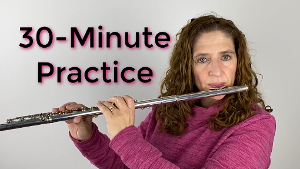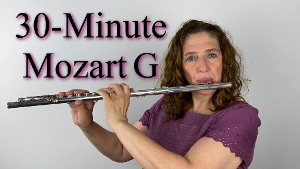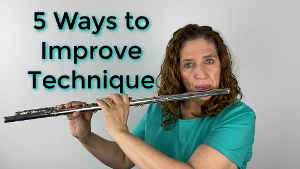No time? No problem? I’m talking about how to get a full practice session done in just 30 minutes.
Life is rarely ideal by giving us all as much time as we want to practice. Instead, life is crazy busy. Whether it’s the job, family, too many classes and papers, or a combination of all of them, life can take away all of our practice time. This holds true if you are an orchestral musician or a college professor too. We all have the events in life that keep us from practicing. But there is a way to keep in shape while making progress on your solos.
What is this beautiful secret? Here it is: Use your solo as your practice.
Yep, I’m saying use your solo to practice all 3 areas of a typical well-balanced practice session: tone/technique, etude, solo. You can definitely learn your solo AND progress as a flutist by practicing only your solo.
Use Your Solo as Your Practice
Yes, you can use your time wisely and get a full practice session in only 30 minutes!
That is what this topic is about – making the most of your limited practice time.
We all have busy lifestyles without the luxury of enough time for practice. There is never enough time for practice. Except when we were flute majors in college and our schedule had built-in time to practice. I did not think so then. If you are a college student now, you probably think you are too busy to get enough practice time. But once you leave school, you will realize that while in school, you did have built-in time to practice. When you are out of school, working a job, trying to make time for your friends, raising a family, making dinner, taking the kids to soccer practice, and to music lessons (kids of music majors must take music lessons) your practice time becomes an absolute premium. So, when you finally get a chance to practice, then you need to make the most of that time.
I have gone through various iterations of what to do when I only have a tiny bit of time to practice. Sometimes that just means that I only run through all my scales and say that I am done! Life is very busy in my household. I have four kids. I have homeschooled them all. I teach at two colleges. I have a large private studio, I maintain DoctorFlute.com, and make videos for this YouTube channel. Life is busy. Those four kids have lots of activities. Finding time to prepare for a recital can be a little bit tricky.
So, I have come up with my plan, and it’s based on the fact that one time when I was in music school and I was talking to one of my piano player friends, I was just flabbergasted when they said all they ever practice are solos. Here I was struggling along in my practice room with my Taffanel and Gaubert and my Marcel Moyse tone studies, and then my Etudes. Then finally, finally when I am all done with all that, I get to practice my five or six different solos that I was working on at one time.
Tone/Technique, Etude, Solo
How does that pianist get away with only practicing solos? I know that there are some Hanon and Czerny books that pianists use in their younger days. But from what I understand, piano majors at music school just work on technique within their solo practice.
That was a revelation to me. I realized that perhaps we flutists can do that as well. Is it ideal? Probably not. I would much rather have my practice time divided into my thirds with enough time to do my tone and technique, enough time to do Etudes and enough time to do my solos. But that’s not always reality once life hits.
Alright, now what? In any practice time, I want to start off with technique. Now there are the people who are tone people and others are technique people. I am a technique person. The first thing I want to do is move my fingers. I know other people who say the first thing they want to do is play a joyous sound. If that is you, more power to you! But it does not work for me. The first thing I want to do is get my lip going by moving. Because I just don’t feel like I’m going to make that joyous sound unless my embouchure is warmed up.
Now in a normal practice session where you have lots of time, you divide your time into 3rds. Technique and tone are the first third of your practice; etudes are a third; solos the last third.
In my 30-minute practice session, I practice with a solo, and concentrate first on technique. For example, if my solo piece is the Bach C major sonata, to practice technique, I will begin with the 2nd movement as it is an Allegro where there are a lot of scale passages and articulations.
Warm Up with Technique
To begin with, I will take a few measures and set my metronome to a tempo that keeps me steady and perfect. Then I will use the Taffanel and Gaubert articulations to play through these measures. This gives me time to move the fingers, wake up the embouchure and practice articulations at the same time. Then I will move down the page practicing a few measures at a time. This is a fantastic way to practice technique and get warmed up.
Tone is next. When I am doing a short practice where I need to accomplish a solo at the same time, I don’t separate technique with tone. Once my embouchure is feeling good, I begin to work on tone at the same time. I listen to what my sound is like and then work on angle of embouchure and try to make sure that it is very relaxed. Next, I go to the slow movement and use that as I would long tones. I play through slowly, concentrating on my tone and generally doing the things I do when I play long tones.
Working on the solo this way includes “etude” practice, but you learn your solo at the same time. Use your 30 minutes and practice thinking your way through the solo. That is, approach the solo like you need to cover all 3rds of your practice time: tone & technique, etude, solo.
The difference between using a solo as your practice and taking a third of your time to practice a solo is in how you think about it. It is all in the approach.
I want to reiterate that this is not the ideal form of practice. Use this method when time is not your friend. When life is just so busy that you either do not practice or go right for the prize (the solo). It will work for you. You will stay in shape and learn your solos. Plus, it may help you keep your sanity when your life gets crazy-busy!
Have fun!
DoctorFlute
What to Do in a 30-Minute Practice Session – FluteTips 119

30-Minute Practice Session Using Mozart Concerto in G

5 Ways to Improve Your Technique Today – FluteTips 141

